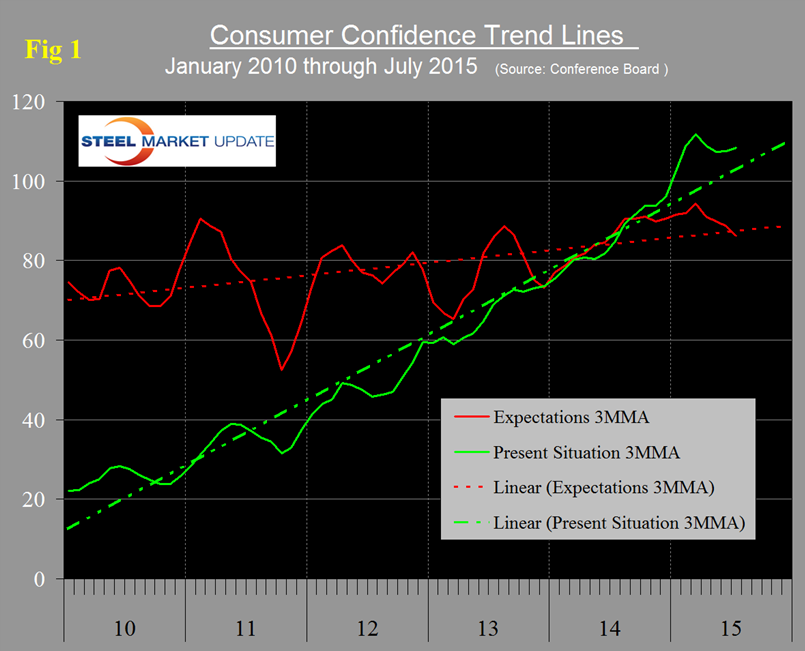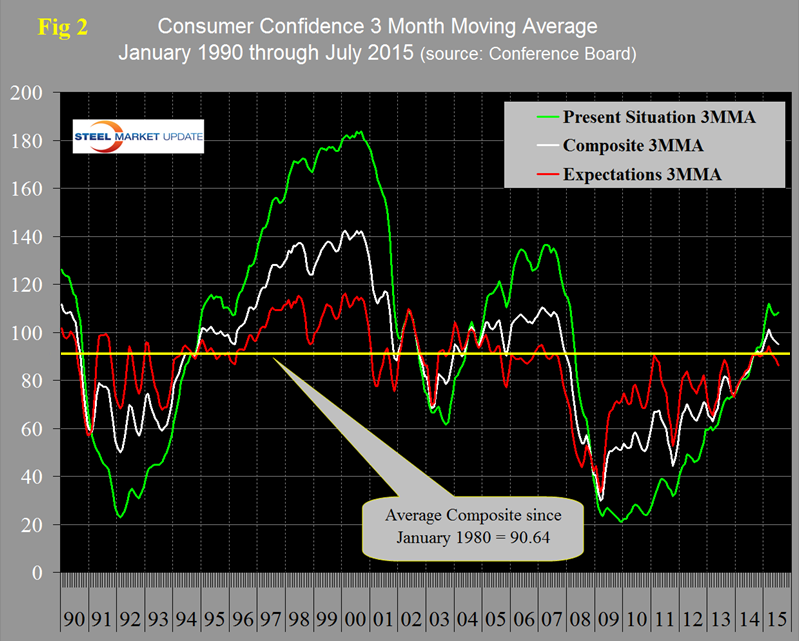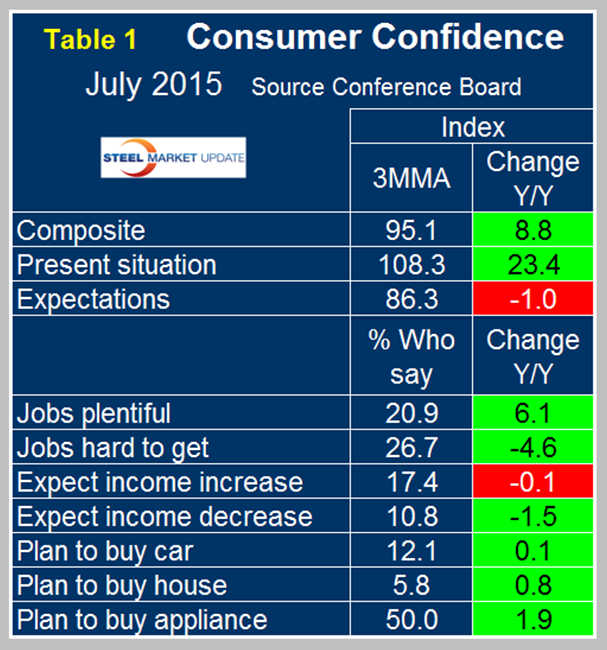Economy

Consumer Confidence for July at 10-Month Low
Written by Peter Wright
July 28, 2015
Consumer confidence took a big hit in July, according to the Conference Board with a decline from June’s 99.8 to a 10-month low of 90.9. In addition there was a downward revision to June’s result. It was a steep slide in the expectations subcomponent that pulled the composite value lower.
The official news release from the Conference Board included at the end of this piece draws quite negative conclusions on a month over month basis. In our opinion this month’s outcome is another example of why not to get too carried away by one month’s result in either direction. The composite value combines the view of the present situation and expectations and its three month moving average (3MMA) declined by 1.1 points. The 3MMA of the view of the present situation improved by 0.8 points and expectations declined by 2.4 points. The composite value of consumer confidence has been much more erratic this year than it was in 2014. In all of last year the monthly change ranged from + 5.1 to – 4.4, this year the range has been + 10.7 to – 8.9 points. There is no multi month trend in recent data therefore we see no reason to be concerned about the July result which is slightly higher than the 25 year average. The 3MMA of the present situation continues to be above the five year trend line and that of expectations is now slightly below its 5 year trend line (Figure 1).
The historical pattern of the 3MMA of the composite, the view of the present situation and expectations are shown in Figure 2.
The recovery of the composite is looking better than the turn around after the recession in 2003. The present situation component has been much more volatile over each multiyear time span than expectations since our data began 35 years ago with higher highs and lower lows. The view of the present situation moved ahead of that for expectations in October last year for the first time since the recovery began in 2009. If history repeats itself, the view of the present situation will continue to move ahead and widen the differential between it and expectations. On a year over year basis using a 3MMA, the composite is up by 8.8 led by consumer’s view of the present situation which is up by 23.4. Expectations at 86.3 are down one point year over year (Table 1).
Three of the four employment sub-indexes which describe job availability and wage expectations have strengthened in the last year as indicated by the color code green. The only red employment sub-index this month was expectations for an income increase which declined slightly. The year over year trends for auto, home and appliance purchase were all negative in March. Intentions to buy an appliance became positive in April, intentions to buy a car became positive in May and in June and July all three were positive year over year. Overall in the first seven months of 2015, the Conference Board index has had the best performance since Q3 2007.
The official news release from the Conference Board follows:
The Conference Board Consumer Confidence Index, which had improved in June, declined in July. The Index now stands at 90.9 (1985=100), down from 99.8 in June. The Present Situation Index decreased moderately from 110.3 last month to 107.4 in July, while the Expectations Index declined sharply to 79.9 from 92.8 in June.
The monthly Consumer Confidence Survey, based on a probability-design random sample, is conducted for The Conference Board by Nielsen, a leading global provider of information and analytics around what consumers buy and watch. The cutoff date for the preliminary results was July 16.
Says Lynn Franco, Director of Economic Indicators at The Conference Board: “Consumer confidence declined sharply in July, following a gain in June. Consumers continue to assess current conditions favorably, but their short-term expectations deteriorated this month. A less optimistic outlook for the labor market, and perhaps the uncertainty and volatility in financial markets prompted by the situation in Greece and China, appears to have shaken consumers’ confidence. Overall, the Index remains at levels associated with an expanding economy and a relatively confident consumer.”
Consumers’ assessment of current conditions was somewhat less favorable in July. Those saying business conditions are “good” decreased from 26.1 percent to 24.2 percent. However, those claiming business conditions are “bad” was virtually unchanged at 17.9 percent. Consumers were slightly less positive about the job market. Those stating jobs are “plentiful” decreased from 21.3 percent to 20.7 percent, while those claiming jobs are “hard to get” increased marginally from 26.1 percent to 26.7 percent.
Consumers’ optimism about the short-term outlook decreased sharply in July. The percentage of consumers expecting business conditions to improve over the next six months declined from 17.9 percent to 14.7 percent, while those expecting business conditions to worsen rose slightly from 10.2 percent to 10.7 percent.
Consumers’ outlook for the labor market was less optimistic. Those anticipating more jobs in the months ahead decreased from 17.1 percent to 13.1 percent, while those anticipating fewer jobs increased from 15.2 percent to 20.0 percent. The proportion of consumers expecting growth in their incomes edged down from 17.6 percent to 17.0 percent, while the proportion expecting a decline increased slightly from 10.6 percent to 11.2 percent.
About The Conference Board
The Conference Board is a global, independent business membership and research association working in the public interest. Our mission is unique: To provide the world’s leading organizations with the practical knowledge they need to improve their performance and better serve society. The Conference Board is a non-advocacy, not-for-profit entity holding 501 (c) (3) tax-exempt status in the United States. www.conference-board.org.

Peter Wright
Read more from Peter WrightLatest in Economy

Steel groups welcome passage of budget bill
Steel trade groups praised the passage of the Big Beautiful Bill (BBB) in Congress on Thursday.

Industry groups praise Senate for passing tax and budget bill
The Steel Manufacturers Association and the American Iron and Steel Institute applauded the tax provisions included in the Senate's tax and budget reconciliation bill.

Chicago PMI dips 0.1 points in June
The Chicago Purchasing Managers Index (PMI) slipped 0.1 points to 40.4 points, in June.

Multi-family pullback drives housing starts to 5-year low in May
US housing starts tumbled in May to a five-year low, according to figures recently released by the US Census Bureau.

Architecture firms still struggling, ABI data shows
Architecture firms reported a modest improvement in billings through May, yet business conditions remained soft, according to the latest Architecture Billings Index (ABI) release from the American Institute of Architects (AIA) and Deltek.



